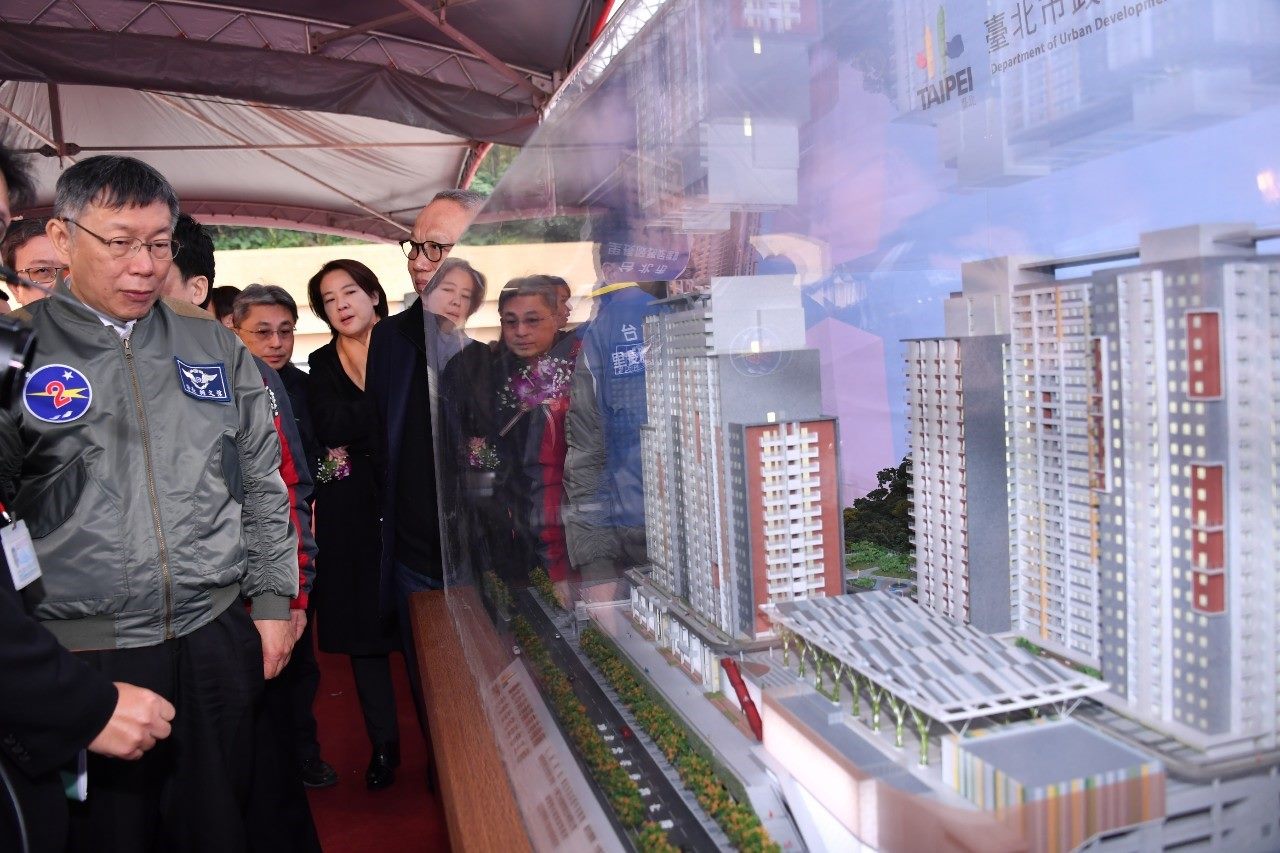Mayor Attends Taipei City Nangang District Nangang Depot Public Housing Turnkey Project Groundbreaking Ceremony
 Taipei City Mayor Ko Wen-Je attended the Taipei City Nangang District Nangang Depot Public Housing Turnkey Project Groundbreaking Ceremony on December 27.
Taipei City Mayor Ko Wen-Je attended the Taipei City Nangang District Nangang Depot Public Housing Turnkey Project Groundbreaking Ceremony on December 27.
During his speech, the mayor mentioned that Nangang Public Housing is the 8th of its kind developed by the city government. To date, 3,334 public housing households have been materialized, and the number is expected to exceed 10,000 after this project is completed, to reach approximately 11,000 households. As the maximum construction capacity is attained, the city government will continue to push for the target of 50,000 households.
Nangang Depot Public Housing is a sub-project of the East District Gateway Project, which is a major focus of the mayor during his 2nd term. Currently, Ko is concentrating on 26 sub-projects including the Taipei Nangang Biotechnology Park building, which was inaugurated several days ago. The East District Gateway Project encompasses the biotech industry and MICE industry, and phase 1 and 2 of the Nangang Exhibition Center have already been completed. Furthermore, the Taipei Music Center will be inaugurated in June next year, and a start-up hub will be created at the Nangang Bottle Cap Factory. The East District Gateway Project is unique in the sense that apart from the biotechnology, music, MICE, and start-up industry, the supervision of projects in the private sector is also carried out by the city government to assist the construction projects of major corporations. Therefore, whether it is CTBC Financial Holding, Taiwan Fertilizer, or Nankang Rubber Tire, the city government will offer them a one-stop service to expedite the proceedings.
Ko also mentioned that while executing the East District Gateway Project, it is important to take the large employment and residential population into consideration, hence the city government acknowledges public housing as an important sub-project. There are currently 6 public housing projects under development, the largest of today is the Nangang Depot Public Housing. With a price tag of NT$7.3 billion, the 2 SRC structures with 27 floors aboveground provide housing units for 1,436 households, making it the largest of its kind in Taipei City in terms of the number of households accommodated. Its importance does not lie only in sheer size, it also possesses 2 crucial characteristics, one of them being start-up hubs. Lower levels of the public housing were already designed with amenities such as activity centers, but the key feature is the introduction of the start-up hub to the third and fourth floors, creating a co-working space. Consequently, many young people will come to live here in the future, as the start-up on the third and fourth floors will facilitate their entrepreneurial endeavors.
The mayor mentioned another critical aspect in that it is the first major piece of architecture built with the circular economy in mind, a concept that has already been implemented in Western European nations when he visited the Netherlands in 2018. As a matter of fact, a building is a high-energy consuming industry and it also generates a large amount of waste, thus the current social and economic development strategy emphasizes sustainability. The building also adopts the strategy of sustainability by utilizing recyclable construction materials, so that when the building needs to be renovated 5 to 7 decades down the line, the construction materials can be recycled and repurposed. That is why recyclable and circular construction materials are used; in addition, the community also stresses the recycling and repurposing of resources and wastes, while flexible modules and the concept of renting instead of buying will be applied.
Ko said that circular economy is in vogue in the global economy, but this is the first time that it has been implemented in Taiwan. Based on his observations overseas, he commented that linkages must be forged with the banking and insurance industry because many of the materials will be reused 5 decades from now. For materials to be reused 5 to 7 decades from now, investments made today can only be recouped 5 decades in the future, therefore it is imperative that the insurance industry is also involved. Since the circular economy has never been officially tested in Taiwan before, hence the city government is also learning on a trial and error basis. As a result, Nangang Depot’s public housing is not only consistent with Taipei City Government’s policy on public housing but also complies with existing standards in green, smart, quake-resistant, and accessible buildings. However, shared space and circular economy are the new features of this building.
Lastly, Ko extended his gratitude to the supervising and construction teams including Sinotech Engineering Consultants Ltd., Taipei International Group and Hwashin Architects, as well as turnkey project teams such as Continental Engineering Corp., Dacin Construction Co., Ltd, Hoy Architects, and H.P. Chueh Architects & Planners. These are some of the best architecture teams in the country, thus they are entrusted with the city government’s tasks such as engineering contracting, design, and construction. The city government feels pleased and thankful for the City Council’s support in facilitating the projects. Lastly, he prayed for successful groundbreaking, safety, and the completion of the projects ahead of schedule, so that they may be opened to citizens.

![Taiwan.gov.tw [ open a new window]](/images/egov.png)
